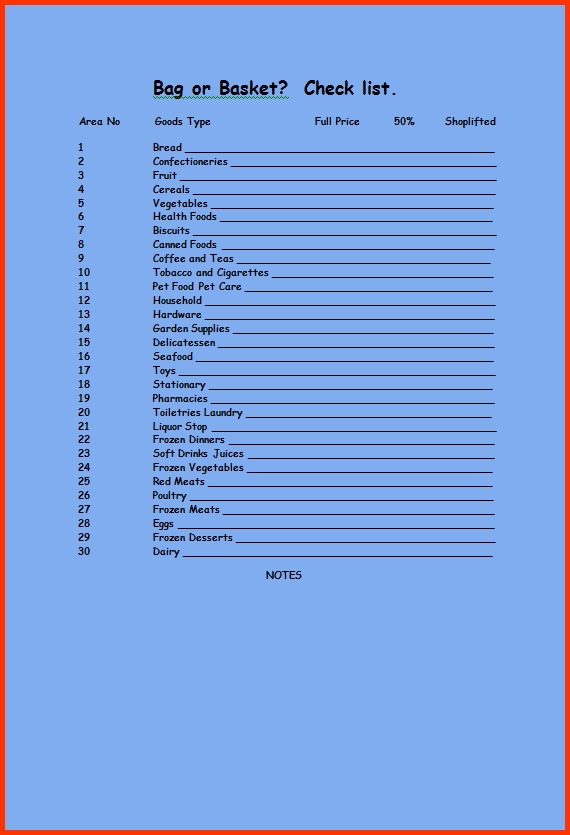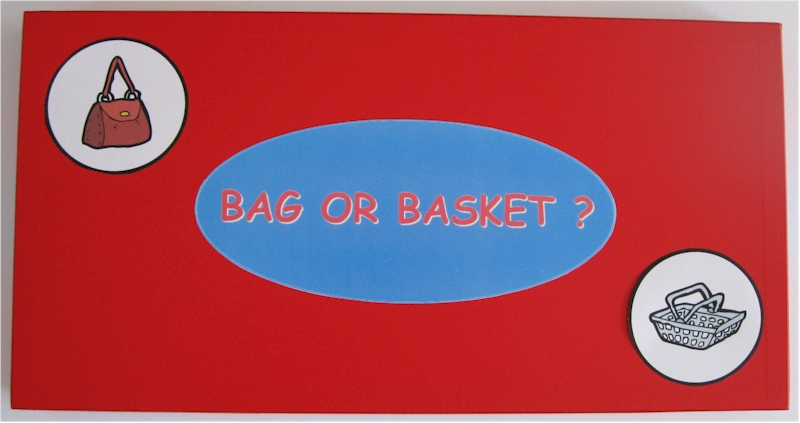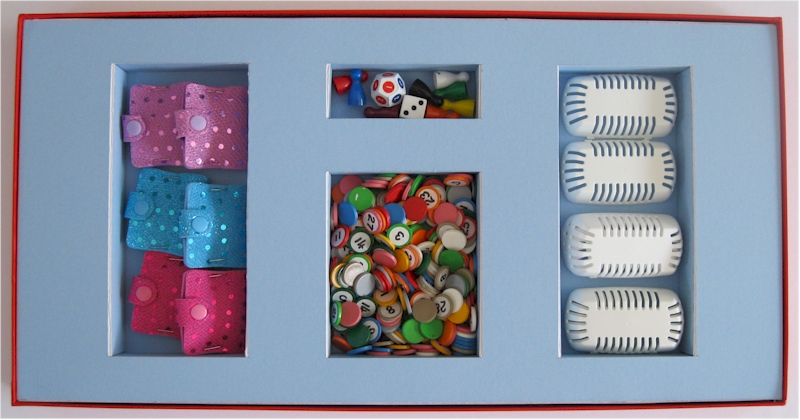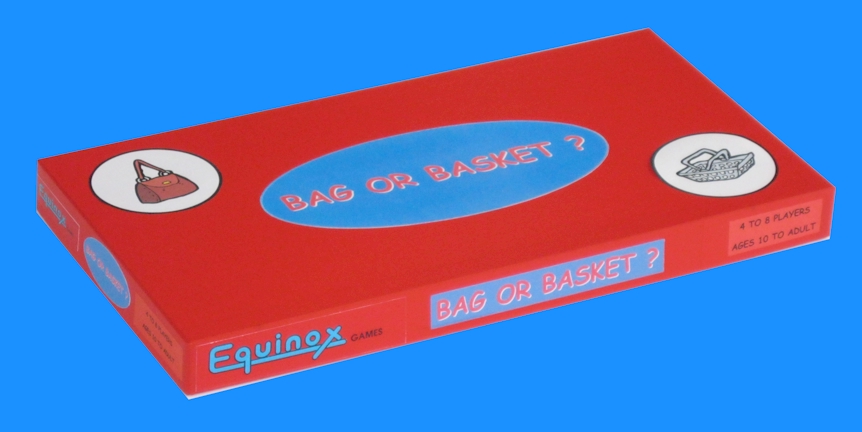CONCEPT:
A board game for four to eight players Bag or Basket? is a game of strategy, risk and observation.
A game set in a supermarket with each player assuming the role of a shopper and the store detective. With a limited amount of money each shopper will try and take advantage of the numerous “red spot” specials and act within the law by placing their goods in their shopping baskets (trolleys) but could at the same time be tempted to dodge the stores security cameras and shoplift by putting goods in their handbags. At various times each player will assume the role of the store detective and request another shopper reveal the contents of their handbag.
OBJECT:
The objective is that each player (shopper) has to pick up $10 worth of goods from each of the thirty different areas of the supermarket. Each shopper would need $300 to do this legally if not taking advantage of the 50% red spot specials that are randomly offered in each of the six shopping lanes. Each player only has $250 and will need at least ten red hot special purchases to achieve all purchases legally otherwise s/he will need to shoplift some goods and risk being picked out by one of the six security cameras that scan each shopping lane at random. The first player (shopper) to obtain the thirty different goods legally or illegally (if undetected) wins the game.
DESCRIPTION OF PLAYING PARTS:
1. The Playing Board.
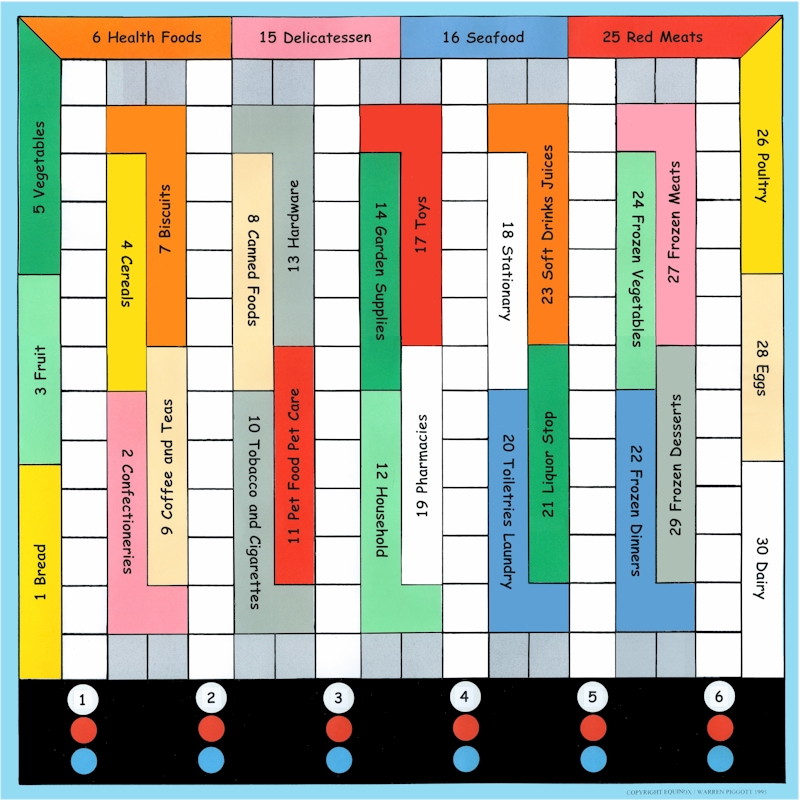
The playing board represents a supermarket with six shopping lanes running front to back, and linked across the front, and across the back of the supermarket. All lanes 1 to 6 plus front and back are divided into ninety-eight stepping squares or playing spaces that the player's (shopper's) travel. Twenty of these playing spaces are shaded and safe from the view of security cameras.
The front to rear shopping lanes are numbered 1 to 6 and each has a red and blue circle indicating “red spot special” or “security camera”.
Also thirty different goods stands are displayed with their type of goods and numbered 1to 30. These stands are shown in ten different colours and there is three of each colour.
2. Playing Pawns. There are eight pawns of different colours. Each one represents a shopper.
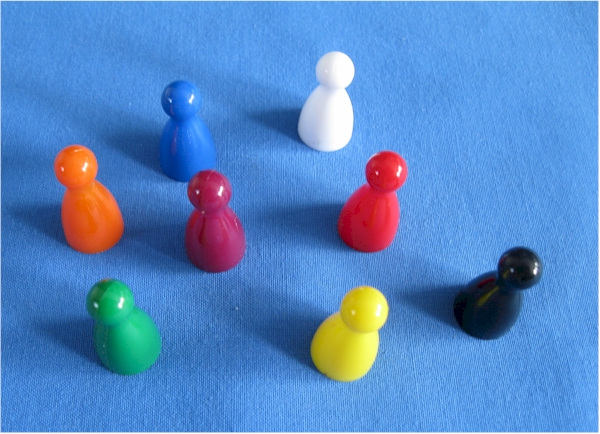
3. Dice. There are two dice. One 1to 6 for general play and one twelve faced (sided) polyhedron or dodecagon dice having 1to 6 faces with a red dot (red hot special) and 1to 6 faces with a blue dot (security camera) for random specials and security. This twelve sided dice is rolled between every second and third throw of the normal dice. The upward face will either indicate a red spot special or a security camera active in a particular shopping lane.
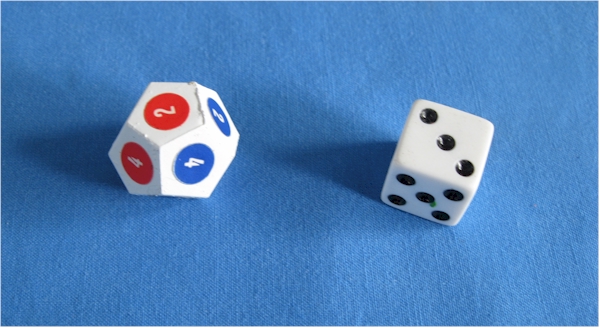
4. Goods Pieces. There are 240 colour coded disc with eight for each separate stand numbered the same. These are representative of each of the goods on the stands. There is one for each player on every stand or enough for up to eight players.
NOTE: The number used is relative to how many players are playing.
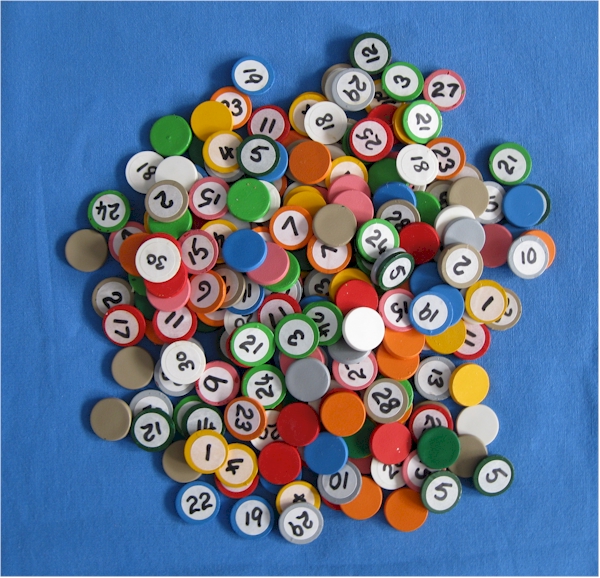
5. Handbags and Baskets. There are eight mini handbags and eight mini baskets for collecting legal and illegal goods.
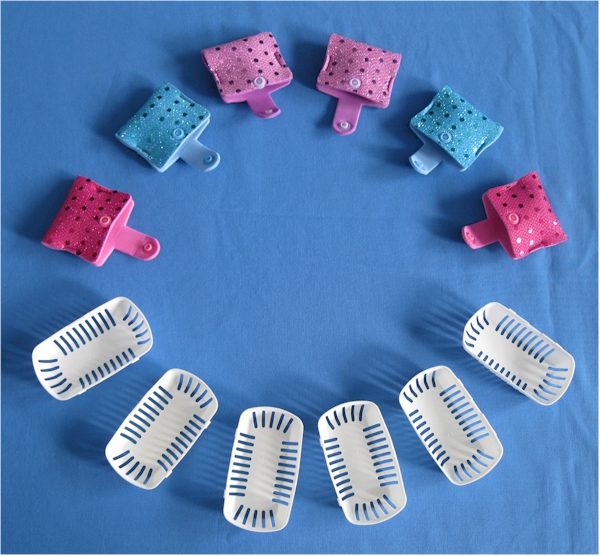
6. Check List and Note Pad. This is set out to list the stall numbers, their type and if the goods are bought at full price, half price or shoplifted. Also to be used to jot down other observations.
7. Rule Book.
TO PLAY:
Once the number of players is decided the board needs to be set up with the same number of 30 separate goods placed in each of the thirty separate goods areas for each player competing. Every colour tablet has a number on one side for the stand in which it is placed with the number down. Every colour of tablet has three colour matched areas of goods with a different number for each. In other words each tablet number needs to match with the number on the goods area.
NOTE: The reason for this is... If caught by a security camera and having shoplifted goods the store detective must be able to accuse accurately from which department they came. As the shoplifter removes any tablet from the handbag they must be careful not to expose its number to anyone. E.g. A security camera becomes active in a particular shopping lane and a player caught in that lane is asked to expose any goods they have in their handbag. The shopper has a blue tablet but does not show it’s area number which could be 16 SEAFOODS, 19 TOILETRIES or 22 FROZEN DINNERS. Now the player that has assumed the role of store detective must declare what area it came from correctly or the shopper is considered not caught. One player, one accusation on only one article can take place for each time a camera becomes active.
Each player is handed a playing pawn, a check list/note pad, a shopping basket and a handbag.
Once the areas are stocked the players (shoppers) can place their playing pawn on any one of the twenty shaded playing spaces on the board.
NOTE: Players cannot remove goods from the ends of goods areas. These are indicated where the playing spaces are shaded.
Players can take from the goods areas along the back wall adjacent to spaces shaded and not shaded but not from the ends of the centre stands.
RULES:
A player can throw the normal 1 to 6 dice to move to another area of the supermarket on his/her turn but not to pick up an item until a following turn. If and when they choose to do this they can move to one of the four shaded playing spaces on either side of the shopping lane they throw with the dice at either the front or the back of the store and then after their next throw of the dice can again pick up goods.
NOTE: This can be done as a strategy move as:- If a player can get to put more than one of the (3) same coloured shop lifted items in his/her handbag it will lessen the chances of being caught. This is because a store detective has to claim correctly that one and only item you are required to show or produce has actually come from a particular area. For example if you have two white disc and one came from Stationary No 18 shelf and one came from Dairy No 30 shelf the store detective is not to see the number on the underside of the disc until s/he nominates the area it came from at which time you show the store detective but nobody else. If it is not the number nominated you have not been caught otherwise if it is you are taken to the store manager to argue the case that you innocently put it in your bag because it fell through the shopping basket. A further dice throw then determines if your excuse is accepted or if you are banned from the store and out of the game.
If two or more players are caught in the same shopping lane at the same time then the player who has just thrown the twelve sided dice and a security camera lane chooses only one shopper to challenge. If s/he is in the lane themself s/he he isn’t subject to being accused.
TO START:
The player with the biggest nose to start first followed by the one with the smelliest feet (If that’s the same player maybe quit now as your probably a loser anyway) and so on to throw the six sided dice in turn. All player respond to every dice throw with one exception (Ref:- “red spot special” and “security camera”
Once the dice is thrown each player moves his/her shopper the number of spaces indicated on the upward face of the dice.
Players can move in either direction on every separate dice throw but not within the one throw. That is to say a player has to move the full amount of spaces indicated in only the direction chosen and s/he cannot for example go four forward one back on a single turn.
When a player has moved his/her piece adjacent to the long side of a goods area s/he can take (one tablet per go) goods from any area within their playing space.
From the fifth playing space along shopping lane number 1 goods from areas, 1 BREAD,
2 CONFECTIONARIES and 3 FRUIT.
A player may now decide to buy goods or shoplift goods from either side of the shopping lane s/he may be in by either placing the goods chosen into his/her basket (bought) or bag (shoplifted) unseen. Players removing goods now record what and where from on their check list.
The dice is thrown again and players respond. Some may continue to shop while others may attempt to move to a shaded space off the shopping lanes in anticipation of a security camera being activated or a quick path to a “red spot special”
“RED SPOT SPECIAL” and “SECURITY CAMERA”
The special twelve sided polyhedron dice is used after every second throw of the regular dice that the players will need to respond to. The upward number 1to 6 will not only indicate the playing spaces that all the players must move (in either direction) but also the shopping lane that indicates either “red spot specials” are available or that a “security camera” has become active.
The twelve sided dice is then to be thrown in turn by the player as was the regular dice. When thrown the special dice will indicate either a “red spot special” or a “security camera” is active in the particular shopping lane revealed by the normal dice that had just been thrown.
The twelve sided dice is placed in line with the shopping lane involved 1 to 6 with the red or blue dot facing up as it landed and the players (shoppers) can either move the same number of spaces indicated 1,2,3,4,5 or 6 to either take advantage of some red spot special or to avoid a security camera.
If a “red spot special” all goods areas accessible from that lane have a 50% reduction on the goods and will remain on special for the next regular dice turn. If a shopper is already in that lane s/he might have the opportunity to take advantage of a second cheaper purchase with the next regular dice throw while other players (shoppers) not in but close by the “red spot special “ lane only have the next regular dice throw reach it and make a purchase while remaining at 50% off or they miss out.
If a “security camera” and a shopper is in the shopping lane indicated s/he is under surveillance and the player (store detective) who threw the twelve sided dice is required to ask to see the contents of the shoppers bag. If more than one shopper is in the lane the store detective chooses just one shopper.
Once the shopper reveals any contents s/he may have without showing any number/s and actual location the detective may suggest an item has been shoplifted from a particular area. Then if correct and the shopper has been caught shoplifting s/he has one opportunity to plead a case (that the goods were too small and would have fallen through the basket) to the store manager. The decision is made with the normal dice (an even number and the shopper is escorted from the store and out of the game otherwise if it’s an odd number s/he gets off. The shopper his/her self can select any other player to throw the decision.
If more than six players the store detective may seek advice from other shoppers as to what may have been shoplifted.
NOTE:
For a player to play well s/he needs to observe what others are picking up from where and what they put in their bag as when they get to role reverse and become store detective they have the opportunity to eliminate their competition. Also they need to record other shoppers “red spot special” and other legal purchases to know they are genuine and not false as well as what they put in their bag. Players are not to hide where they place the goods they collect it’s up to their completion to notice and record. Remember there are three tablets for each different area of goods.
Play continues until a player can claim to be the first to have collected legally or illegally one goods tablet from each of the thirty areas of the supermarket having spent no more than $250.
